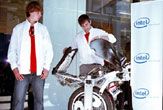Motorcycle Balances Segway-Style

The Tango sports bike is basically a single-wheel motorcycle, an all-electric personal transportation vehicle created by two high school students from Oakville, Ontario.
The Tango has two side-by-side wheels, and it uses an R6 Yamaha frame with hand-machined parts. It uses electronics to detect angle of tilt and motion.
“You sit on it just like the R6 (Yamaha) sports bike,” Gulak said, “…and to drive forward just lean forward and it drives right under you, and if you want to turn just lean to one side and the suspension takes care of it and you lean and that’s it.” “Accelerometers... give the relative position of the bike relative to the ground so the driver leans forward and gives it angle and the speed at which he’s leaning forward. And that’s what we use to control the wheels.”
The Tango (see photo) can reach top speeds of up to forty miles per hour.
Science fiction fans may remember the tumblebug from Robert Heinlein's 1940 novel The Roads Must Roll:
Gaines and Harvey mounted tumblebugs, and kept abreast of the Cadet Captain, some twenty-five yards behind the leading wave. It had been a long time since the Chief Engineer had ridden one of these silly-looking little vehicles, and he felt awkward. A tumblebug does not give a man dignity, since it is about the size and shape of a kitchen stool, gyro-stabilized on a single wheel. (Read more about Heinlein's tumblebug)
This great prototype vehicle is much cooler than the Eunicycle Single-Wheel Gyro-Stabilized Scooter, but maybe the Bombardier Embryo design might look a little cooler (but no prototype). Also, see an illustration of Heinlein's tumblebug from the original story publication in Astounding Science-Fiction for June, 1940.
Via Teen scientists rev their motors.
(This Science Fiction in the News story used with permission from Technovelgy.com - where science meets fiction.)
Sign up for the Live Science daily newsletter now
Get the world’s most fascinating discoveries delivered straight to your inbox.
- Great Inventions: Quiz Yourself
- Zoom! The Rocket Bike
- The Most Dangerous Sports in America












